 |
| Lt. Gen. U.S. Grant |
"If he comes this way, we will take our old line;"
Grant and Lee Move into the Wilderness
by
James F. Epperson
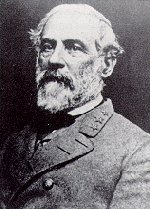 |
| Gen. Robert E. Lee |
|
"If he comes this way, we will take our old line;" Grant and Lee Move into the Wilderness by James F. Epperson |
|
Copyright 1998 James F. Epperson
All rights reserved
An edited version appeared in Columbiad, Spring, 1998
 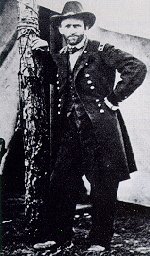  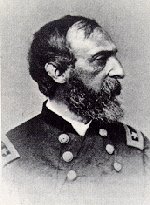    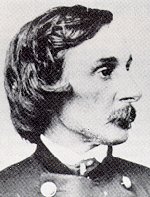  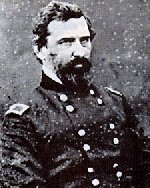  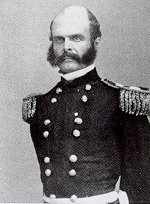  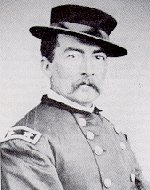 | One of the least-studied campaigns of the Civil War is the Overland Campaign of 18641, in which U.S. Grant and Robert E. Lee, perhaps the two most successful commanders of the war, first came to grips with each other. And one of the least-studied aspects of the Overland Campaign is the opening movement, by which Grant crossed the Rapidan River on Lee's right flank and the two armies came to battle in the Wilderness of Spotsylvania.2 The campaign that followed was unparalleled in the Civil War. For forty days the two armies were in close contact without respite, and the resulting casualties were horrendous. When a pause finally came it was in the trenches at Petersburg, and the men had nine more months of mud and bloody stalemate before the war would come to a close. Surprisingly little has been written on the Overland Campaign, and what has been written tends to overlook and even confuse the events of the first two days, when the armies were first set in motion. This is unfortunate because the events of the first several days are of course magnified in importance as their consequences creep forward in time. Could Grant have crushed Lee in the Wilderness, thus ending the war without the casualties of Spotsylvania, Cold Harbor, and Petersburg? Or might Lee have been able to decisively thwart the newest Federal hero and prolong the stalemate enough to cause Lincoln's defeat and win independence for the Confederacy? Unfortunately, a substantial amount of mis-information, mis-conception, and even mythology, surrounds the historical study of the opening operations (May 3-5) of the Overland Campaign. As a result, the casual reader who reads the standard sources (Douglas Southall Freeman, Bruce Catton, Shelby Foote, James McPherson) will get an incomplete and, frankly, erroneous view of what happened. Only Edward Steere's3 1960 study appears to recognize the true nature of these crucial days and his work is overlooked and therefore under-appreciated. Even recent scholarship4 sometimes appears to miss the essence of what happened. As a result we have something akin to a myth that has grown up surrounding the opening of the Overland Campaign. According to this myth, Grant was attempting to move south past Lee's flank towards Richmond, and did not want to fight in the Wilderness; but Lee figured out Grant's operational plan, and set out to fight in the Wilderness in order to negate Grant's numerical advantage, and deliberately maneuvered so to force a fight in that hellish terrain; in fact---so goes the myth---Lee precipitated the battle by striking the flank of Grant's moving column. In fact, each of these statements is false, and this can be readily demonstrated. Only the point about the extent to which Lee chose to fight in the Wilderness is open to serious debate. The thrust of this article can be readily phrased in contrast with the standard myth. Grant was moving west, towards Lee's army, and this was part of the original concept of the campaign, he was quite willing to engage Lee within the confines of the Wilderness, and Lee did not figure out Grant's plan---quite to the contrary, the battle was precipitated by Lee essentially ordering his advanced infantry corps to develop the Federal intentions; in addition, there is no reliable evidence from the period to support the notion that Lee actually desired a battle within the Wilderness, what evidence does exist is thin and suspect, there are sound military reasons for Lee to want to avoid battle in the Wilderness, and there is substantial evidence that Lee wanted to fight behind the entrenchments at Mine Run; finally, the battle began with the two armies more or less blundering into each other, and the first day's fighting consisted of a serious of Federal attacks on isolated Rebel units, which should have resulted in the defeat of Lee's army. That it did not is due largely to the failures of an inexperienced Federal cavalry division commander. One key to understanding the development of the Federal plans for the spring of 1864 lies in the final maneuvers of the previous campaign season and the winter-time positions which the armies held. Since the detachment of troops westward in the fall of 1863, both armies had sparred and maneuvered across the Virginia landscape but no major battles had been fought. Perhaps the most important action from the perspective of this study was the abortive Mine Run Campaign, which occurred in late November of 1863. Although it precipitated no major combat, Maj. Gen. George Meade did lead his Army of the Potomac south across the Rapidan and then westward towards Lee's army, encamped in the general vicinity of Orange Court House, some 35 miles west of Fredericksburg. With his right flank threatened Lee skirmished and then fell back to a position behind Mine Run, a small stream about 18 miles east of Orange Court House, and constructed a substantial set of field works to cover his southward (right) flank. A Federal assault was planned for Nov. 30, but was called off when Maj. Gen. Gouvernor K. Warren, in command of the troops who were to lead the attack, concluded that the enemy was too strongly entrenched for an attack to be successful. The Federal army retired north of the Rapidan and went into winter quarters. Lee had planned an attack of his own, holding the Mine Run works with just a fraction of his force and using the rest to swing around and take the Federals by their own southward (left) flank, hoping to roll them up into the space between Mine Run and the Rapidan.5 Both armies had learned a lot in this campaign, despite the lack of pitched fighting. In particular, the Federals had learned that they did not want to engage the Rebels when the latter could take refuge behind the Mine Run works, and they had also learned---so they thought---how quickly the enemy could react to a force crossing to his right. The Army of the Potomac spent the winter of 1863-64 in winter quarters near Brandy Station, Virginia, while the Army of Northern Virginia took up a position along the Rapidan River, roughly from Orange Court House eastward to the mouth of Mine Run. When Lt. Gen. James "Pete" Longstreet's First Corps returned from its unfortunate sojourn in East Tennessee it went into camp near Gordonsville, at the far west (left) of Lee's line, and somewhat to the south of it.6 As winter warmed into spring, both armies began to prepare for the opening of active campaigning. On the Federal side of the Rapidan, the most important change was no doubt the arrival of U.S. Grant as Lieutenant General and General in Chief of all Union armies. Although Meade retained his post as commander of the Army of the Potomac it was clear that Grant would be the guiding force behind the plan of the coming campaign. Grant's objective in the planning of the spring campaigns was to bring constant, simultaneous, and relentless pressure to bear on all of the Rebel armies in the field. With respect to the operations of the Army of the Potomac, this led him to opt for a campaign plan that built largely upon the Mine Run experience. While subordinate forces under Franz Sigel (in the Shenandoah Valley) and Ben Butler (along the James River in front of Richmond) operated against the supply lines and sources of the Army of Northern Virginia, Meade's Army of the Potomac, reinforced by Burnside's IX Corps, would operate directly against the Confederate legend, Robert E. Lee, and his equally legendary Army of Northern Virginia. There were a number of constraining factors working to constrict Grant's total freedom of operation:
The importance of this last point cannot be overemphasized. Previous campaigns against Lee and his army had foundered when the Confederate leader took the offensive after absorbing the best blow that the Yankees could deliver. It was vital to force Lee into battle in such a way as to remove his freedom of action. The sum total of all this led to the following operational plan:
Authorship of the plan is due to Meade's Chief of Staff, Maj.-Gen. A.A. Humphreys, one of the more engaging and combative, but lesser-known, generals of the war. Grandson of the man who designed the U.S.S. Constitution, Humphreys had commanded a V Corps division at Fredericksburg and Chancellorsville, and then a III Corps division at Gettysburg. After the Gettysburg campaign he agreed to become Meade's chief of staff.7 Writing after the war, he described the process of arriving at the plan in his postwar study of the campaign: "The movement by the left flank was adopted, and I was requested to prepare a project for it. Two were sketched out by me, the one turning Lee's right by the Catharpin and Pamunkey roads in comparatively open country, the other by roads having about the same general direction as the Pamunkey, but from five to eight miles eastward of it, passing two to four miles west of Spotsylvania Court House. The two projects were coincident for the first day and for a part of the second, and both were subject to material modification or entire abandonment on the second day, dependent upon the movements of Lee. "The first project was adopted, and the order of movement was prepared by me in conformity to it. The order for continuing the movement on the 5th of May, issued on the evening of the 4th, also conformed to it, but owing to indications of the enemy's movement on the 4th, the order of march was partial only, and held in view the probability of a general engagement on that day."8 The orders as drawn up amounted to a large right wheel as the Army of the Potomac crossed the Rapidan River. As Humphreys indicated in the above, the precise disposition of forces on the second day of the operation would depend on what Lee did on the first day. Humphreys claimed that he based the timing and speed of the operation on the rapidity with which Lee responded to the similar maneuver by Meade during the Mine Run campaign the previous fall. As it turned out, Lee reacted more quickly this time, and one can't help wondering if Humphreys should perhaps have compensated in his estimates for the difference between winter campaigning in bad weather by tired troops, and spring campaigning in good weather by fresh troops. It is almost impossible to overstate the importance of the terrain through which the armies would be moving at the start of the campaign. The Wilderness of Spotsylvania was a roughly 100 square mile tract of second-growth forest, bounded on the north by the Rapidan River, on the south by the Po River and the Catharpin Road, and extending roughly from Locust Grove to near Salem Church, west to east. Clever manuevering of large bodies of men in this terrain would be nigh-on impossible, as units could be fragmented and disorganized simply by moving forward. The jungle-like growth was broken only by the occasional farm clearing, and the major roads were few and far between. The principal north-south road was formed by the combination of the Germanna Plank Road and the Brock Road. Together these two ran all the way from the Rapidan River at Germanna Ford to near Spotsylvania Court House. Roughly three-fourths of the Federal army would use some part of this road during the pre-battle maneuvering. There were three main east-west arteries. The northernmost was the Orange Turnpike, sometimes called the "stone road," which ran slightly north of east from Orange Court House to Chancellorsville. To the south of the Turnpike was the Orange Plank Road, which ran from Orange Court House to Wilderness Church, about 2 miles west of Chancellorsville. Just east of Orange Court House these two roads were only about a mile apart, but at New Verdiersville they began to diverge, so that in the western Wilderness they were about three miles or so apart. The third east-west road was the Catharpin Road, which was about 4 to 6 miles south of the Plank Road. Connecting routes between the east-west roads were few and of poor quality; shifting a force from one road to another would be a difficult task. The Army of the Potomac began to move at midnight, May 3-4, 1864. The combat troops were formed into two columns for the march. In the right (or, westward) column, Brig. Gen. James Harrison Wilson's Third Cavalry Division forced the crossing of Germanna Ford and led Warren's V Corps to its assigned destination, Wilderness Tavern, located at the intersection of the Germanna Plank Road and the Orange Turnpike. Behind V Corps came the VI Corps under Maj. Gen. "Uncle John" Sedgwick. From the Tavern, Wilson led his division westward along the Turnpike; his orders were to send out "strong reconnoissances [sic] on the Orange plank and pike roads, and the Catharpin and Pamunkey roads, until they feel the enemy."9 The left (or, eastward) column was led by Brig. Gen. David McM. Gregg's Second Cavalry Division, followed by Maj. Gen. Winfield Scott Hancock with the II Corps and the army's Reserve Artillery. By early afternoon of May 4th Hancock had reached his assigned destination, Chancellorsville. While the lead elements of the army could easily have marched further on the 4th, it was considered important not to get too far ahead of the lumbering supply train or Burnside's IX Corps, which was making a forced march from its rearward position along the Orange and Alexandria Railroad; stopping at noon also would allow the men to rest in anticipation of any action the following day.10 Besides, based on the experience of the previous November, Lee would not be able to significantly interfere with the Federal operations until late the next day. What were Lee's plans for this campaign? Actually, very little is known. Many of the reports and records of the Army of Northern Virginia were lost during the retreat from Richmond next spring, and Lee of course never wrote his memoirs after the war. What little evidence exists suggests that Lee was anxious to bring Grant to battle quickly, but beyond that we have no direct evidence of a specific plan. We do know, from some notes penned two months later by one of Ewell's staff officers11, that the Confederate commander was worried about his infantry getting entangled with the enemy before Longstreet could be brought up to join the main body of the army. Confederate reaction to the Federal move was rapid. The Confederate signal station on top of Clark Mountain had determined that the Army of the Potomac was in motion during the early hours of the morning12 but it took some time to determine for sure the direction of motion and to get the Confederate units formed and on the march. One of the first orders Lee issued to Ewell was to occupy the Mine Run works, which were on Ewell's immediate right.13 From the army's winter quarters Lee could use all three east-west roads to advance toward the apparent path of the Federal army. Ewell's avenue of advance would be along the Turnpike, and it was here that the battle would begin. The Plank Road would be A.P. Hill's avenue of advance and would see the most furious and significant fighting of the eventual battle. The Catharpin Road was used by Longstreet in his approach march.14 As night fell on May 4th, Ewell had his Second Corps in camp in the vicinity of Robertson's Tavern and Locust Grove along the Orange Turnpike, only four miles west of Warren's encampment around Wilderness Tavern. (The advance pickets would have been even closer.) A.P. Hill, accompanied by Lee himself, was at New Verdiersville. Longstreet, with the longest march to make, was enroute to Richard's Shop along the Catharpin Road, about four miles south of New Verdiersville; Old Pete's veterans would be making an all night march to try to catch up to the rest of the army. At the same time the Federal V Corps was in camp around Wilderness Tavern, with VI Corps camped along the Germanna Plank Road between the Spotswood farm and Germanna Ford. Hancock's II Corps was at Chancellorsville with the Reserve Artillery and Burnside was coming along at a quick pace. (In fact, his lead division, 1/IX under Brig. Gen. Thomas G. Stevenson, was encamped just across the Rapidan at Germanna Ford.) Lee's cavalry is actually conspicuous by its absence, despite the oft-repeated assertion that his cavalry chief, Maj. Gen. J.E.B. Stuart, was doing his usual superb job15. Of the three divisions of horse troops, only one makes an appearance as an organized force; this is Maj. Gen. Fitz Lee's division which spent the late winter near Hamilton's Crossing, four miles south and slightly east of Fredericksburg. The Federal advance threatened to cut Fitz off from his uncle's army and so he spent the 4th and 5th of May in motion towards the west, avoiding direct contact with the Federal columns. Not until late on May 5th was this division used in any meaningful way. Of Rooney Lee's division we know even less. Steere suggests via a map16 that it was left behind at Orange Court House in case the initial Federal advance was a feint. The history of one of Rooney's regiments states that (at least) one brigade actually crossed to the north side of the Rapidan to keep an eye on Federal movements in that quarter, and did not join up with the main body of the Rebel cavalry until after the Battle of the Wilderness. Most of Wade Hampton's division apparently spent the winter at Milford, even further away to the south of Fredericksburg than Fitz Lee. (One brigade of Hampton's division had wintered in South Carolina and was still making its way north.) Yet it is a brigade of Hampton's division, under Brig. Gen. Tom Rosser, that would perform the most significant service of the Confederate cavalry prior to the opening of the battle. This brigade wintered near Waynesboro, at the edge of the Shenandoah Valley, and was marching eastward to rejoin the rest of the division when the campaign began.17 More is known of the Federal cavalry and we shall eventually see that this amounts to embarrassment for several of the Union officers involved in its management and leadership. Gregg's Second Division was directed to cover the eastern flank of the Federal deployment, towards Fredericksburg. Wilson's Third Division was supposed to screen and scout along the roads leading westward, towards Lee's winter camps. Wilson's job was obviously the more important of the two, yet his division was the smallest of the three and he was not only new to the Army of the Potomac but was in his first field command of the entire war, having heretofore served mostly as a staff officer to Grant. The remaining division, Brig. Gen. A.T.A. Torbert's First Division, was originally supposed to cross at Germanna Ford on the morning of the 5th and support the V Corps/VI Corps column, but this assignment was changed on the night of May 4th. Incredibly, neither Grant nor Meade were aware on the evening of May 4th that Ewell was so close. Despite direct orders to the contrary, Wilson had failed to leave so much as a cavalry patrol on the Orange Turnpike and thus had missed Ewell's advance, apparently by no more than a few minutes.18 This was perhaps the most serious error of the entire campaign, as it led both Meade and Grant to misinterpret the appearance of Ewell's troops on the V Corps front the next morning, and it denied them the information necessary to properly plan the movements of May 5th. Insofar as the infantry was concerned, Grant's orders for May 5th involved only a modest modification of the original Humphreys plan. Instead of a wide sweep to the south, with II Corps probably on the Pamunkey Road and V Corps on the Catharpin Road near Craig's Meeting House19, the army would take a slightly tighter turn and deploy along a line facing west, with the troops to be held ready to move forward, i.e., westward. Hancock would be on the Catharpin Road at Shady Grove Church, with his right extended northward through the Wilderness to connect with Warren and the V Corps, who would be at Parker's Store on the Plank Road. Sedgwick would deploy on the Turnpike, to Warren's right. Burnside's IX Corps would be in reserve. The tighter turn was based on what little information the Federals had of Rebel movements from the signal tower on Stony Mountain north of the Rapidan. This information indicated that the Rebels were not taking up the Mine Run position, but were coming forward to meet the Federal Army. Unfortunately, Wilson had not done his job, so neither Grant nor Meade knew just how close the enemy was. (Note that Grant's orders clearly envisioned an advance westward toward Lee, and this was part of the original plan of campaign. Contrary to many casual accounts of the campaign, Grant was not trying to steal a march past Lee's flank, he was in fact turning to meet Lee's army. Moreover, the fact that the May 5th deployment line was within the Wilderness itself strongly implies that Grant was not worried about fighting in that terrain.) The Federal cavalry orders for May 5th turned out to be a disaster of errors and wasted effort. For some reason Grant and Meade were overly concerned with Fitz Lee's division, which spent the night in the vicinity of Massaponax Church, south and slightly east of Hancock and Gregg at Chancellorsville. From this position he could be a threat to the supply train which would be crossing the river on May 5th and going into park at Chancellorsville, as well as to the rear of Hancock's column as II Corps marched west to Shady Grove Church. Accordingly, Torbert's First Cavalry Division was ordered to cross the Rapidan at Ely's Ford instead of Germanna Ford, and proceed to link up with Gregg's Second Division at the Aldrich Farm, there to keep watch on Fitz Lee. Why it was felt necessary to use two Federal divisions to keep watch on a single Rebel division is unknown. (It is possible that the Federals were unaware that the Rebel cavalry had been organized into three divisions. The third division, under Rooney Lee, had only recently been formed upon the exchange from prison of its commander. If the Federals thought that Fitz Lee's division was half the Rebel cavalry, instead of only a third of it, then they might well have reasonably wanted more force to contain it.) In the event, Fitz Lee decided it was more important to concentrate on the Confederate main body, so he spent May 5th moving westward by roads somewhat to the south of the Wilderness in order to avoid contact with the Federals; meanwhile, Torbert spent the day struggling to pass through the long supply train to link up with Gregg. The net effect of the Federal orders for their cavalry was to take one division off the board entirely. We can only speculate what might have been the effect if Torbert had crossed at Germanna Ford and supported and screened Warren's column. Wilson was ordered to continue screening the roads leading westward and to move his main body to Craig's Meeting House along the Catharpin Road, about five miles in advance of Shady Grove Church, where Hancock was supposed to deploy his troops. However, Wilson continued to display a cavalier attitude towards his screening mission. Instead of leaving active patrols across the entire front of the army, he left a single regiment (5th New York) along the Plank Road, and promptly disappeared into the thickets towards Craig's Meeting House. There he met Rosser's Confederate cavalry brigade, at about 8 a.m. After a three hour firefight---which nearly resulted in the destruction of his division---Wilson was forced back along the Catharpin Road all the way to Todd's Tavern20. Unbeknownst to Grant or Meade, the Federal army would be making its right wheel towards the enemy almost completely blind. With some notable exceptions, Lee's orders for May 5th can only be surmised, based on the movements of his troops as they actually occurred. Longstreet was ordered to continue his march forward to join the main body; it was anticipated that he would reach Richard's Shop along the Catharpin Road by the end of May 5th. A.P. Hill was directed to advance down the Plank Road. Stuart was apparently ordered to take the available cavalry---which was probably nothing more than Rosser's Brigade of Hampton's division---and proceed down the Catharpin Road. The only written order from this evening that survives is to Dick Ewell: General Lee directs me to inform you that he will be found in the woods opposite this house tonight. He wishes you to be ready to move on early in the morning. If the enemy moves down the river, he wishes to push on after him. If he comes this way, we will take our old line. [Emphasis added.] The general's desire is to bring him to battle as soon now as possible.21 This order does not support the notion that Lee knew what Grant's intentions were---quite to the contrary, it strongly implies that Ewell was to help him establish the Federal intentions. Essentially, Lee was using his two infantry corps to conduct a reconnaissance-in-force along the Turnpike and Plank Roads. What is especially ironic is that this order also states very flatly that if Grant were to do what he was in fact doing (i.e., moving toward the oncoming Confederates), then Lee would want to take up his "old line," which can only mean the Mine Run position.22 In addition to this order of May 4th, there is a dispatch sent by Lee to President Jefferson Davis, also on May 4th, which says, "You will already have learned that the army of Gen. Meade is in motion, and is crossing the Rapidan on our right, whether with the intention of attacking or moving towards Fredericksburg, I am unable to say."23 Some information was received during the night from various cavalry patrols. Fitz Lee sent a report strongly suggesting that the Federals were moving in the general direction of Mine Run, yet Stuart sent one suggesting that the Federals were concentrated near Wilderness Church, which was about three miles east of where Warren's troops were actually camped.24 Then there is the account of Maj. Campbell Brown, who was Ewell's step-son and aide-de-camp. According to Brown, who reported to Lee on the morning of May 5th for verbal clarification of the orders received the night before, the commanding general said that Ewell was not to allow himself to become involved with the enemy in a situation where he could not disengage. "If the enemy advanced and showed a willingness to fight," recalled Brown, General Lee "preferred falling back to our old position at Mine Run."25 Ewell himself, in his official report of the battle, spoke of getting essentially the same clarification even later that morning when he sent another aide, Sandie Pendleton, to consult with the commanding general,26 and Brown's notes also mention Pendleton getting similar instructions. Although Lee later clarified to Maj. Brown that his intent was not to fall back unless Ewell could not maintain his position, it still is the case that, as late as the morning of May 5th, Lee's orders to his forward-most corps commander were not consistent with the idea of striking the Yankee main body while it was in the Wilderness.27 This puts us close to establishing that Lee did not deliberately maneuver so as to force a fight in the Wilderness, but there is more to be said here. It certainly is true that the dense terrain of the Wilderness would hamper maneuver and tend to nullify the Federal numerical advantage, and moreover would make the superior Yankee artillery less of a factor. For these reasons, a kind of military common sense would dictate that combat in the Wilderness would work to the advantage of the Confederates. But there are just as strong common sense arguments in favor of the opposing view. The same terrain that would nullify the Federal numerical advantage would limit the ability of Lee to maneuver. It would be like making a lightweight but quick-footed boxer fight in a tub of molasses. That Lee was concerned about this is evident in the recollections of Maj. Brown and the testimony of Ewell's report. Just as important are Lee's established tendencies. He had made his sterling reputation as a counterpuncher, by absorbing the first and best blow that the enemy could make, and then riposting with deadly force. In fact, Lee's only clear-cut defeat (Gettysburg) had come when he had acted on the operational as well as tactical and strategic offensive. His formula for success in the Seven Days and Second Manassas Campaigns, as well as at Chancellorsville, had been the counterattack. There is no reason to think that he would want to change his pattern in the first days of the 1864 campaign, and this argues that Lee intended to accept battle wherever he could get it on terms of tactical advantage, rather than seeking it in any particular place. In addition, it argues that he would prefer open country where he would have a free hand to maneuver. It must be admitted, however, that there is contemporary testimony, of a sort, which implies that Lee did specifically desire to fight Grant in the tangled undergrowth of the Wilderness. Despite the fact that Lee was usually reticent to talk about pending operations with his staff, there are accounts from two Confederate staff officers stating that Lee commented on Grant's failure to learn from previous Federal misfortunes in the Wilderness: |      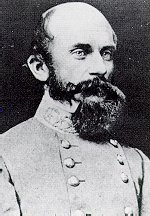  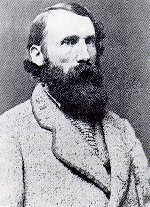  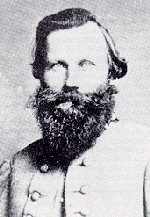 |